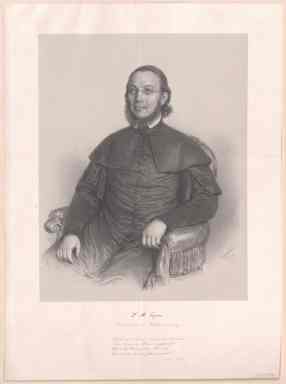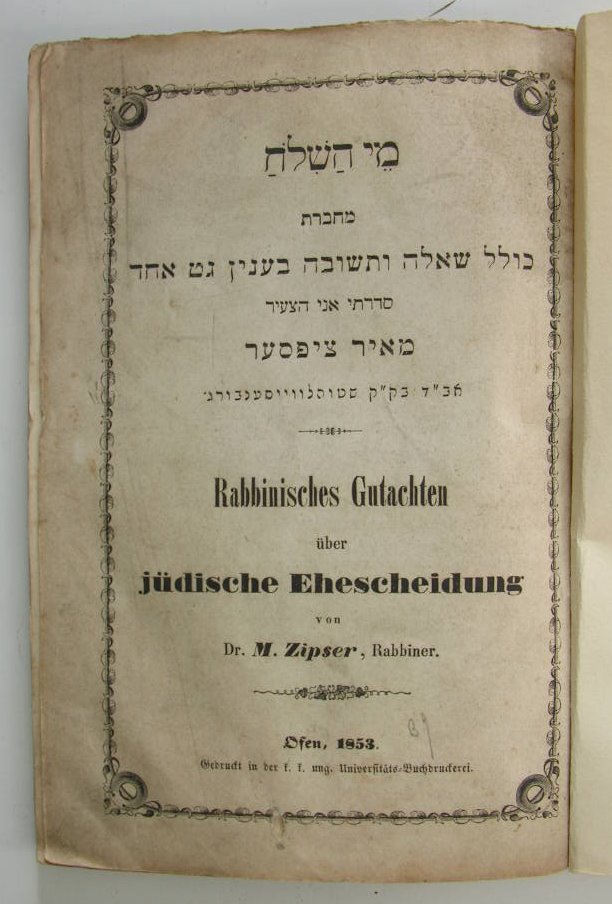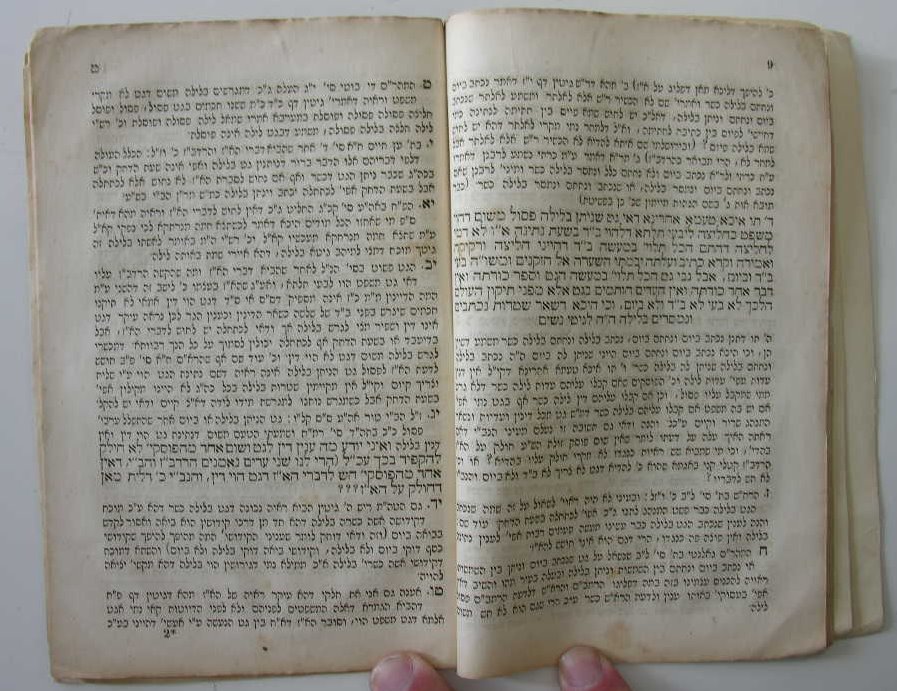Maier Zipser
Maier Zipser (1815-1869)
Chief Rabbi Maier (or Majer) Zipser z'tl born in Balassagyarmat, 14. August 1815. - died at Rohonc (today Rechnitz, Austria), 10. December 1869. Rabbi, one of the leaders of the Conservative (Neolog) movement of the Hungarian Jewry.
He studied in various yeshivot, first in his hometown, Balassagyarmat at the yeshiva of Rabbi Meir Eisenstädter, then, at age of 15 he went to Prossnitz, Moravia (today Prostějov, Czech Republic), to the yeshiva of Rabbi Nehemias Trebitsch. Following his master, he continued his theological and philosophical studies in Nikolsburg (today Mikulov, Czech Republic). The talented, hard-working Zipser studied German and French language, studied the works of Schiller and Shakespeare. As he was granted a rabbinical diploma (semikhah) in 1837, he returned to his hometown for a while. Subsequently, he was working in Alt-Ofen (Óbuda) as an educator of the families Goldberger and Bobély. He could study the rich private library, and learned Greek and Latin language. While still engaged in his talmudic studies, he acquired a broad general, secular education partly through the assistance of Löw Schwab, rabbi of Pest, partly through his own endeavors, and graduated from the University of Pest in 1851.
In 1844 he was appointed rabbi of Székesfehérvár (Stuhlweissenburg). The young rabbi was an unswerving devotee of progression. As soon as he assumed his position he called for reforms in the order of prayer: the exclusion of the piyyutim (liturgical poems) from the obligatory prayers and their recital in silence. They prayed for the emperor and the political authorities in Hungarian. A group of Jews, insisting to the tradition, with the leading of a disciple of the famous Moses Shreiber (Chatam Sofer), Gottlieb Fischer attacked Zipser on account of a divorce bill (get) which he had granted without a precedent (by which although he had not violated the rules of the Talmud, but he didn't act according to the strictest tradition as it was generally accepted in his era ). In his defense he wrote a pamphlet in 1853 entitled Mei ha-Shiloah ("Waters of Siloah"): Rabbinisches Gutachten über Jüdische Ehescheidung (Rabbinic opinion on jewish divorce).
He reformed education: in 1844 he established a Jewish elementary school instead of the traditional private school (cheder). He created the Statute of the jewish community (1845) in the spirit of the reform, which lead to a lot of debate, conflict. The Chevra Kadisha ("Holy Society" , ie. burial society) of Székesfehérvár was found in 1853. Zipser had a great role in preparing its statutes. Such as in Hungary, in Székesfehérvár also, the Jews were strongly divided by the consideration of the efforts to progress and the reforms. It's lead to the leaving of Zipser in 1858 and finally to the disruption of the community in 1862 into Orthodox and to Neolog (Conservative).
In 1850 he went to England, where he published his apologetic work "The Talmud and the Gospels" (1851). It was republished by the community if London in 1852 as "the Sermon on the Mount Reviewed..." , in reply to statesments made by two members of parliament, Inglis and Newgate.
The Bach-era (Alexander Bach was Austrian minister of the interior at the time with the mission of transforming Hungarian public administration in such a way that all chance for commotion should be eradicated; the 1850s are therefore also referred to as Bach era in Hungarian historiography) and the conflicts in his community made him dishearten so he planned to emigrate to America, or to England, where he would hope the implementation of his reforms rather then in Hungary, where most of the jewish communities did not want to hear about them. Finally in 1858, Zipser accepted a call from the community of Rohonc (today Rochnitz, Austria) where he was working until his death in 1869. He actively participated in the works of the Jewish Congress in 1868.
Most of his religious and historical studies were published in the Litteraturblatt des Orients, and in the Jewish Chronicle. Zipser reports in the press the expulsion of the Jews from Székesfehérvár during the events of March, 1848. (Eine Szene aus dem ungarischen Kriege- A scene from the Hungarian war).
His studies published in the Litteraturblatt des Orients:
- Die jüdischen Zustände unter der 150-jährigen Türkenherrschaft (The state of the Jews under the 150-years Turkish occupation of Hungary) (1846- 47);
- Zur Biographie des R. Meir Eisenstadt (A biography of Rabbi Meir Eisenstadt) (1846-47);
- Raphael Meldola. Ein Bild der jüdischen Zustände in Italien zu dessen Zeit (Raphael Meldola. A Raphael Meldola. A picture of the situation of the Jews in Italy in his era) (1846 - 47);
- Kritische Untersuchung über die Originalität der im Talmud und Midraschim vorkommenden Parabeln u. Sentenzen. Critical study on the originality of the parables and aphorisms occurring in the Talmud and Midrashim (10 studies);
- Die magyarische Sprache u. die Juden (The magyar language and the Jews);
- Über die talmudischen fremdsprachigen Wörtererklärungen (Explantations of the foreign words in the Talmud);
- Zur Charakteristik der Hillelischen Schule u. deren Lehren (Characterization of the Hillel-school and its teachings);
- Über das Erbrecht des weiblichen Geschlechts nach dem Evangelium (About the succession of the female sex to the Gospel);
- Über das jüdische Kalenderwesen, eine Kritik des Luzzatto'schen Calendario ebraico (On the Jewish calendar, a critique of Luzzatto's Calendario Ebraico).
Studies published in the Jewish Chronicle:
- Eine Szene aus dem ungarischen Kriege (A scene from the Hungarian war);
- The Talmud and the Gospels (1851., 13 studies), which was republished by the community if London in 1852 with the title "The Sermon on the Mount Reviewed..." ,
He was working also for the journals "Allgemeine Zeitung des Judentums) and "Ben Chananya", journal of Lipót Lőw, Chief rabbi of Szeged. His studies which were published in this paper:
- Zur Zoologie des Talmud (Zoology of the Talmud) (1858);
- Zur Geschichte d. israelitischen Gemeinde in Belgrad (History of the jewish community of Belgrade) (1859);
- Zur Geschichte der Sabbatfeier (History of the festival of Sabbath) (1859);
- Über die Ostrichtung unserer Tempel (On the east direction of the Temple)(1860);
In addition, his ceremonial speeches and sermons were also published. From the manuscript found in his heritage, Adolf Jellinek, Chief Rabbi of Vienna published the translation of Josephus Flavius' work: Über das hohe Alter des jüdischen Volkes gegen Apion. Nach hebräischen Originalquellen erläutert und nach M. Zipsers Tode ausgegeben und bevorwortet (Against Apion, About the antiquity of the Jewish nation) (1870). His biography and picture was published in Reich's booklet, Beth-El 5. (1862).
Sources:
- Hungarian Jewish Lexikon. Ed by Péter Ujvári, Budapest: Magyar Zsidó Lexikon. 1929. p. 974. Reach online
- http://sofar.sofargo.hu/hu/node/37679

- Kinga Frojimovics : Triple road: trends of the Hungarian Jewry from their division until their forced merger. In: Land of Hagar. Hungarian Jewry - history, community, culture. Ed. Anna Szalai. Kossuth Kiadó, Budapest 2009. p. 103.
The book "Über das hohe Alter des jüdischen Volkes gegen Apion" is fully available in German original on ![]() .
.
(Yechiel)








